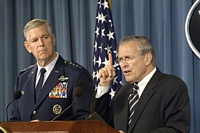Nuclear Brief September 21, 2005
 |
|
JCS Chairman Gen. Meyers says the revised
doctrine has been changed considerably; Defense Secretary
Rumsfeld says he hasn't seen it. |
Pentagon Top Rejects Criticism Of Doctrine
Defense Secretary Donald Rumsfeld and Joint Chiefs of
Staff Chairman General Richard Meyers rejected the criticism of the
Pentagon's
revised Doctrine for Joint Nuclear Operations. The doctrine
was critiqued in
an article in
Arms Control Today and portrayed by the
Washington Post
as lowering the nuclear threshold by incorporating preemption into U.S.
joint nuclear doctrine for the first time.
The rebuttal, which was given in response to a
question during
the regular Defense Department press briefing on September 20, was
both poorly documented and poorly articulated. The excerpt from the
briefing follows:
Q: A question for both of you
gentlemen...as you've seen by published reports, apparently -- and
would you bring us up to speed -- apparently, there is a draft memo
making its way through the Pentagon originating somewhere in the
Joint Chiefs spaces about the possible use of nuclear weapons in a
preemptive strike against terrorists and nations that would use
weapons of mass destruction against U.S. or its assets. Can you sort
of bring us clear on all of that?
GEN. MYERS: There has been, back in
1995 and then again in 1996, a companion piece in our joint -- what
we call our joint doctrine. There is joint doctrine that considers
where nuclear weapons fit in the arsenal. That is in the process of
being updated. As you might imagine, the primary piece that's being
updated is this notion going from a nuclear triad that we used to
know of bombers, missiles and submarines to a triad of nuclear
weapons, conventional weapons and infrastructure -- being
Intelligence and the Department of Energy and so forth. So this new
notion of a new triad that came out, I think, in 2001 or early 2002
-- bringing our doctrine up to speed with that. The fundamentals
don't change, of course. The president always retains the right to
use all options at his disposal, and he's the ultimate decision
authority, of course, on the use of any nuclear weapons. And that --
and that hasn't changed.
The article is based on doctrine
that was out for coordination at the lieutenant colonel/colonel
level. It had not been to general officer/flag officer level yet.
And since, whatever piece they saw, has been modified since then. I
mean, that doesn't even reflect the current addition. I have not
seen it, but I got updated on it, I know where we are. So it's --
it's the business we're in in trying to explain our -- our doctrine.
Q: One quick follow-up. Mr.
Secretary, is part and parcel of that the so-called nuclear
bunker-buster that we believe you are in favor of?
SEC. RUMSFELD: I doubt it. I haven't
seen the -- the --
GEN. MYERS: This doesn't go into
specific weapons, and it --
SEC. RUMSFELD: Right. I don't think
it does.
GEN. MYERS: And the one that -- and
the -- I think the hint or allegation in the article was this
somehow lowers the nuclear threshold, and that's not at all true. In
fact, if anything, it emphasizes the role that conventional weapons,
as they become more accurate, can play in helping with not only
deterrence, but dealing with weapons of mass destruction. They're --
of course -- well. So that's -- it's a separate issue, the -- that
is a separate issue."
Rebuttal of a Rebuttal
Contrary to Gen. Meyer's claim, however, the draft
doctrine incorporates significant nuclear changes compared with
the previous version. The changes are described in detail in
my review of the doctrine in Arms Control Today and
the analysis elsewhere on this web site.
Specifically, Gen. Meyers' claim that the revised
doctrine "emphasizes the role that
conventional weapons, as they become more accurate, can play" is
incorrect. Rather, the doctrine emphasizes the role of nuclear weapons
with conventional weapons described as potentially playing a future role
to complement the nuclear weapons in some missions.
Moreover, Gen. Meyers does not
acknowledge that nuclear preemption is in the draft doctrine, or that it
will be removed in the final version.
The rebuttal reveals an administration that appears
uncomfortable with publicly acknowledging core elements of its own nuclear reform.
This reform is based on changes created by the 2001 Nuclear Posture Review, the
2002 directive to combat Weapons of Mass Destruction, as well as STRATCOM's
new Global Strike mission. Denying that new nuclear roles are being incorporated into the doctrine appears particularly silly
given the emphasis the Bush administration has placed on the
importance of their development.Confirming
this development, obviously, would mean saying: "yes, we're taking nuclear to
a new level," which would contradict the Bush administration's
claim of reducing the role of nuclear weapons. To that end it is relevant to
remind of
Gen. Meyers' prepared statement to the
Senate and House Armed Services Committees in February 2005 about
a recent update to the
strategic nuclear strike plan:
"STRATCOM has revised our
strategic deterrence and
response plan that became effective in the
fall of 2004. This
revised, detailed plan provides
more flexible options to assure allies, and
dissuade, deter, and if necessary, defeat
adversaries in a wider range of contingencies."
(emphasis added)
|

